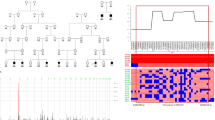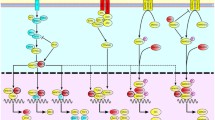Abstract.
In mammals, during fetal development, the eyelids grow and flatten over the eyes and temporarily fuse closed. Failure of this normal developmental process in mice leads to the defect, open-eyelids-at-birth. Nearly all newborns of the GP/Bc strain, homozygous for the spontaneous recessive mutation, gaping lids (gp), have bilateral open eyelids at birth, with essentially no fusion between the upper and lower eyelids. Histological sections and scanning electron microscopy of GP/Bc eyes during the normal period of eyelid growth and fusion indicate that gp/gp mutant fetuses have deficient upper and lower eyelids; surface periderm cells that appear to have some role in eyelid growth and fusion are present, but lack a normal ``streaming'' pattern toward the fusion zone. No other defects due to the gaping lids mutation were detected. A genetic analysis based on outcrosses of GP/Bc to various linkage marker stocks and to CBA/J and ICR/Bc normal strains was done. Penetrance in F2 segregants, but not in BC1 segregants, was usually significantly less than 100%, was strongly affected by the identity of the normal strain used, ranging from 44% to 92%, and indicated a potential complexity of modifiers. Forty-one affected F2 and 120 BC1 segregants from the outcross of GP/Bc to CBA/J, and 23 affected F2 segregants from the outcross to ICR/Bc, were used to map gp to proximal Chr 11 between the centromere and D11Dal1 (Camk2b), an interval previously defined as less than 1 cM. Sets of whole F2 litters from the crosses to CBA/J (n = 106) and ICR/Bc (n = 65) strains were typed for informative SSLPs near gp (D11Mit62 and D11Mit74, respectively) and demonstrated that the segregation ratios in the region are Mendelian. The known genes in the interval, Nf2 and Lif, do not seem to be obvious candidate genes for gp. An Egfr-null allele was used to confirm the previously reported map position of the potential candidate locus, Egfr, to a more distal interval, between D11Mit62/226 and D11Mit151, from which gp had been excluded. Tests for allelism showed that the Egfr mutation and the gp mutation complement each other, and therefore also indicate that they are at different gene loci. Open-eyelids-at-birth is associated with several mutations at other loci with variable penetrance owing to modifiers and in other more complex genetic liabilities in inbred strains, and the genetics of this trait is a model for other genetically complex developmental threshold traits. The gaping lids mutation identifies a previously unknown locus on proximal Chromosome (Chr) 11 that has a strong role in fetal eyelid growth.
Similar content being viewed by others

Author information
Authors and Affiliations
Additional information
Received: 13 January 2000 / Accepted: 23 February 2000
Rights and permissions
About this article
Cite this article
Juriloff, D., Harris, M., Banks, K. et al. Gaping lids, gp, a mutation on centromeric Chromosome 11 that causes defective eyelid development in mice. Mammalian Genome 11, 440–447 (2000). https://doi.org/10.1007/s003350010084
Published:
Issue Date:
DOI: https://doi.org/10.1007/s003350010084



